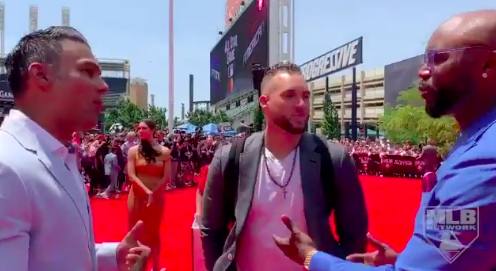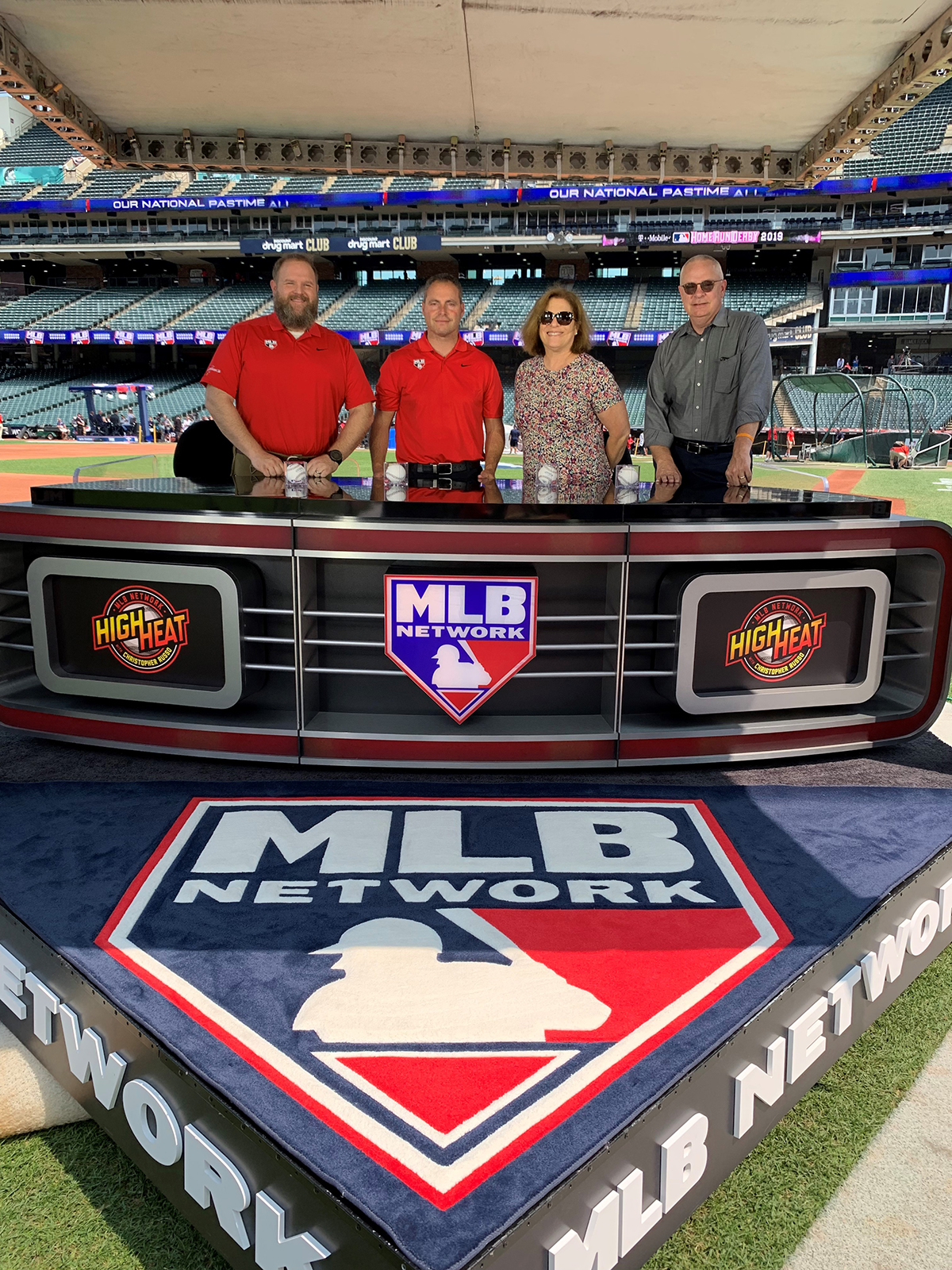Live From MLB All-Star 2019: MLB Network’s Production Grows as All-Star Festivities Expand
Besides the world feed, the broadcaster provides hours of linear and streamed content
Story Highlights
Although MLB All-Star Week is a flashpoint of activity for all the broadcasters onsite, no entity is busier this week than MLB Network. In addition to producing more than 14 hours of live onsite linear programming from Cleveland over three days, MLB Network is also once again handling the world-feed production of the All-Star Game, serving up dozens of hours of streaming content to digital outlets and social channels, and managing a mass of video feeds to all onsite broadcasters using its custom FATS (feed another trailer something) system.
“This event just keeps growing, and it may sound cliché, but it’s truly a team effort for us here,” says MLB Network SVP, Operations and Engineering, Susan Stone. “Our operations and technical teams do a tremendous job of putting this together and giving production all the tools that they need to do the incredible job that they always do. Even though it’s more of a challenge because we’re not in the studio, the production team is running at its highest level here. We try to replicate what we do in a controlled studio environment here as much as possible. That’s a result of a lot of hard work and dedication.”
Non-Stop All-Star Week: Multiple Live-Streamed Productions
Although MLB Network’s live onsite programming began Sunday night with the All-Star Futures Game from Progressive Field, its work began a day prior with multiple live-streaming productions of the High School Home Run Derby; Junior Home Run Derby; Pitch, Hit and Run Finals; All-Star Miracle League Game; and events from Play Ball Park (including the VR Home Run Derby). In addition to the Futures Game on Sunday, MLBN also dealt with a full slate of 15 regular-season games.
On Monday, MLBN produced special All-Star editions of High Heat With Christopher Russo and Intentional Talk from Progressive Field, as well as MLB Tonight’s live Media Day coverage from the Huntington Convention Center.
Today, MLB Network is producing the MLB All-Star Red Carpet Show, which begins with a parade through the streets of downtown Cleveland and culminates at the centerfield gate of Progressive Field.
MLB Network is also helping deliver live-streamed shows on MLB.com, DAZN, and other digital platforms, as well as behind-the-scenes content from batting practice and other events on the Twitter, Instagram, Facebook, and Snapchat platforms,
To handle all this content, MLB Network has deployed a whopping 42 outbound transmission paths, 18 inbound transmission paths, and 12 paths between the Convention Center and Progressive Field carrying the VR Home Run Derby, as well as a 13-camera mux for the Media Day coverage. A total of 45 cameras are scattered throughout Progressive Field and the Convention Center, along with three Mobile Viewpoint bonded-cellular cameras to cover the Red Carpet Parade.
“We’ve taken on a lot of additional responsibilities in terms of digital content, but we’re also producing more content than ever for linear [onsite],” says MLB Network SVP, Production, Dave Patterson. “What’s cool about All-Star is, we get to come here and we can do ENG to compile hours and hours of content, and then we get to do live studio programming and then also do live games as a remote. We are able to combine everything we do really well all year into a three-day period here at All-Star. I think this is a great showcase of who we are as a network.”
Inside the Compound: Game Creek Pride, New REMI Suite Join the Party
MLB Network’s production compound is located in Rocket Mortgage FieldHouse’s underground compound area, which is connected to Progressive Field’s compound, where Fox Sports is located. MLB Network is once again using all Game Creek Video trucks with one notable change: the Pride mobile unit (A and B) replaces Riverhawk as the home to its onsite studio shows. Maverick and Edit 3 are handling the world-feed production for the third straight year, and Webby has been deployed as the home of the Red Carpet Show production.
“One of the big changes we’ve made this year is expanding our RF comms, which were geared towards the studio shows in the past,” says Jason Hedgcock, senior manager, remote technical operations, MLB Network. “We’ve now expanded that system, and it includes our digital folks and world-feed crew as well. We are repurposing gear as much as possible rather than just letting it sit here idle, which I think has made things a lot more efficient.”
This year, MLBN has erected a “REMI suite” to handle QC for the at-home workflow of its digital/streaming productions, which are being run out of control rooms at its headquarters in Secaucus, NJ. This move was based partially on a lack of space — MLBN trucks’ control rooms are maxed out at this point — but also to enhance flexibility across all its shows.
“The addition of the REMI suite was based on what we learned from last year,” says Hedgcock. “The nice thing is, we have access to our whole arsenal of cameras and can send any camera to any REMI show. We can send cage cameras or hard cameras to our Twitter show, and that can really bolster a show that may not have had access to those resources in the past.
MLB Network also once again has a media-management trailer onsite and expanded its use of Aspera high-speed file transfer to enhance file-sharing between Cleveland and Secaucus.
And the network is working with Bexel to manage the FATS system, which sends camera feeds to Fox and ESPN and also helps power the IPTV system for monitors scattered throughout the All-Star setup.
On the Field, on the Red Carpet, and Inside Media Day
The network has brought back its primary rover set on the field (featuring three cameras and a jib), which can be struck and carted off the field in less than six minutes, as well as a secondary set near the right-field foul pole — both supplied by Filmwerks. MLB Network has four up cameras deployed specifically for its onsite studio show inside the ballpark, as well as three RF cameras roving the field with talent. MLBN also has access to batting-cage cameras and the Skycam system deployed by Fox Sports.
“We feel like we have a really good plan and rhythm from previous years, so we’re not making a lot of changes, and it’s pretty status quo in terms of the sets,” says Tom Guidice, VP, remote operations, MLB Network. “We love our set down on the field, and it’s always exciting once we get down there. Between the field set, the outfield set, Red Carpet, and Media Day, we’ve got a lot of [locations] this year.”

Carlos Pena (left) and Cliff Floyd (right) are once again on hand as style analysts for MLB Network’s MLB All-Star Red Carpet Show
The league has expanded the Red Carpet Show this year, adopting a dual approach, featuring both a parade (beginning at the player hotel near the Convention Center) through the streets of downtown Cleveland and a proper Red Carpet Show at the centerfield gate at Progressive Field. MLBN has a Z-stage located at the red-carpet location to interview players as they arrive.
“Red Carpet is a combination of a traditional parade and what we did last year in Washington, DC, where it was really truly a red carpet more than a parade,” says Stone. “There are a lot of different social activations, so that’s a huge focus for us this year. Baseball took what we did last year in Washington with all of the activations at the end and added the parade on the frontend.”
MLB Network’s Cliff Floyd and Carlos Peña are once again serving as fashion reporters, and Heidi Watney is roaming throughout the parade festivities.
“Because we’re back to a parade, we needed a lot more wireless cameras this year,” says Hedgcock. “But, instead of using the more traditional RF cameras, we’re using Mobile Viewpoint bonded-cellular cameras.”

MLB Network’s Media Day operation featured 12 Admiral Video gooseneck cameras at player pods, including Hunter Pence’s
MLB Network’s All-Star Media Day operation also continues to grow with each passing year. MLB once again worked with Admiral Video to deploy 12 Marshall miniature gooseneck robotic cameras on interview pods for Media Day (plus a robo overseeing the entire room) on Monday. The 12 feeds were used for MLB Tonight’s linear telecast covering Media Day, as well as streamed on MLB.com and each of the 12 players’ team sites.
The systems marry the audio from two mics at each pod and were fed to a flypack created by MLB Network (instead of using Admiral Video’s truck as it did last year) at Progressive Field, which is about a mile away from the Convention Center.
“We basically built a REMI setup that is coming here [to our flypack at Progressive Field] instead REMIing it back to us at home in Secaucus,” says Hedgcock. “That saved us having to put more trucks at the Convention Center, which is rather far away. [In years past], we would have had to have another mobile unit over there, where 13 cameras [were deployed] for Media Day plus some feeds for VR Home Run Derby and PlayBall Park. We would have needed a full truck and transmission and all of that. This way, we were able to leverage our resources here for the Convention Center coverage.”
Peña also conducted roving interviews, which were transmitted via Dejero EnGo mobile-transmitter units.
CLICK HERE for more of SVG’s Live From MLB All-Star 2019 coverage.

